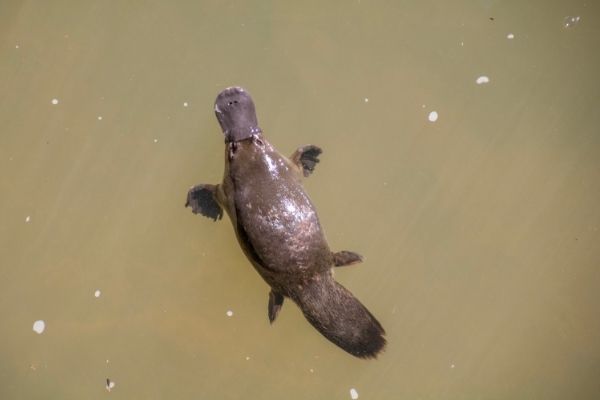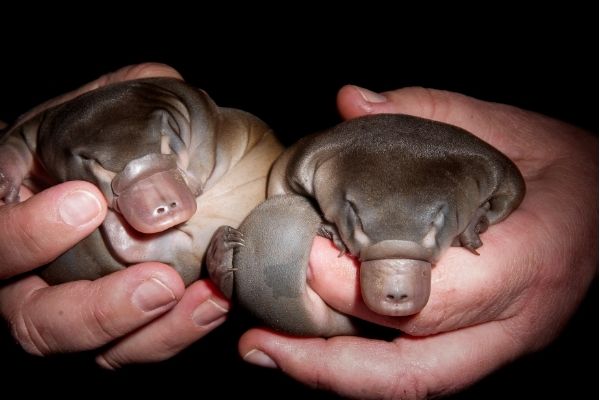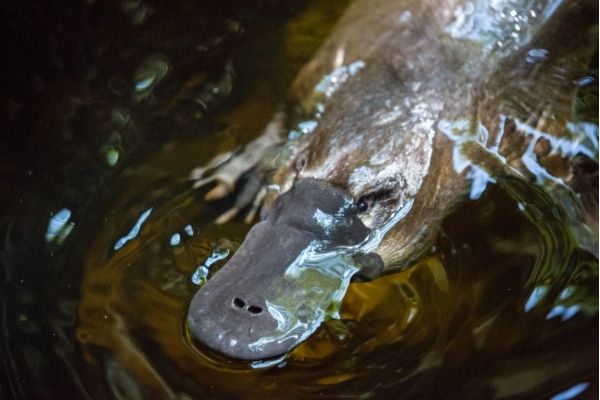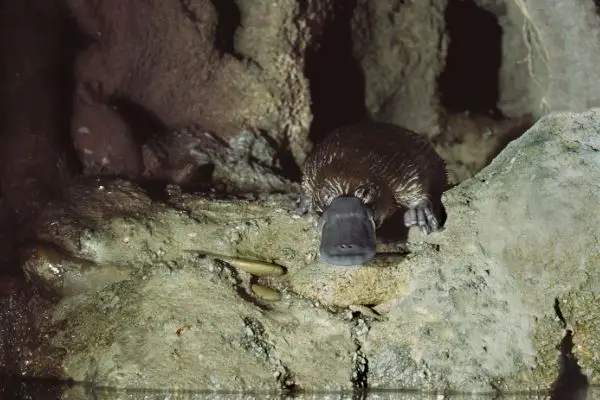Duckbill Platypus is a very unique animal that lays eggs and is classified as a mammal. Due to this uniqueness, it is a very interesting animal to learn. We have listed down complete Platypus Facts for Kids that will help you in learning all about Platypus. You are going to learn about its scientific name & classification, evolution, appearance, physical features, physical abilities, diet, habitat, lifespan, reproduction, babies, behavior, adaptations, food chain, ecological role, endangerment, population, predators, and many other interesting facts about Platypus.
Platypus Facts For Kids
What Is A Platypus
- A platypus is an egg-laying mammal native to eastern Australia.
- It is also sometimes known as the duckbill platypus because of its duck-like bill.
- Platypus is a semi-aquatic animal with unusual features. It has a duck-like bill, otter-like feet, and beaver-like tail.
- It is the only living representative of the genus Ornithorhynchus and the family Ornithorhynchidae.
- Platypus is one of the five animal species along with four species of echidna (spiny anteaters) that lay eggs instead of giving birth to live offspring.
- Platypus is also one of the few venomous mammal species.
- Its conservation status on the IUCN Red List as Least Concern.
Scientific Name Of Platypus
- The scientific name of platypus is Ornithorhynchus anatinus.
Scientific Classification Of Platypus
- The following is the scientific classification or taxonomy of platypus:
| Kingdom | Animalia |
| Phylum | Chordata |
| Subphylum | Vertebrata |
| Class | Mammalia |
| Order | Monotremata |
| Family | Ornithorhynchidae |
| Genus | Ornithorhynchus |
| Species | Ornithorhynchus anatinus |
Platypus Evolution
- The modern monotremes (egg-laying mammals, platypus, and echidnas) are believed to have survived from an early branching of the mammalian tree, while a later branching is believed to have led to placental and marsupial (pouched) groups of mammals.
- It is believed that monotremes split from other mammal groups (placentals and marsupials) about 166 million years ago.
- Fossil dating and molecular clock suggest that platypus and echidnas split from each other about 19 to 48 million years ago.
- The oldest excavated fossil of the modern platypus is about 100,000 years old and belongs to the Quaternary period.
What Does A Platypus Look Like
Appearance
- Platypus has a very unusual appearance.
- Their bills resemble that of the ducks, their feet are like that of the otters, while their broad tails are like that of the beavers.
- The gait of platypus is like that of reptilians. Their legs are located on the sides of their body rather than underneath.
- They have a streamlined body, broad tail, and wide feet.
- Their body and tail have a covering of dense waterproof fur. Their fur resembles that of the moles.
- They have webbed feet. Webbing on the front feet is more significant than the hind feet. The webbed part of their feet folds back when they walk on land.
- The beak of the platypus is an elongated snout, in which the lower jaw has a covering of soft skin.
- On the dorsal surface of the snout, the platypus has nostrils. The ears and eyes are located in a groove on either side of their heads, which they close during swimming.
- Their jaws have a different built from that of the other mammals. The muscles at their jaw opening are also different.
- Young platypus has milk teeth on each of their jaws. However, it replaces heavily keratinized pads (grinding plates) as they become adults.
- Both male and female individuals have spurs on the back of their ankles. However, only the spurs of male individuals can deliver venom.

Color
- The fur color of the platypus ranges from brown to dark-brown on the upper body side and brown to silver-grey on the ventral side of the body.
- Their fur is biofluorescent and glows in a bluish-green color when exposed to black light.
Physical Features Of Platypus
Length
- The average head and body length of a platypus is 15 inches (38 cm). While their tail is 5 inches (12.7 cm) long.
- Males usually have larger body sizes than females.
- The average total body length of a male platypus is about 20 inches (50 cm) while that of females is about 17 inches (43 cm).
Weight
- The average body weight of platypus is 3 lbs (1.36 kg).
- However, it greatly varies and ranges from 1.54 to 5.92 lbs (0.7 to 2.4 kg).
Physical Abilities
Speed
- The swimming speed of a platypus is around 1 meter per second.
- When foraging, they swim at a lower speed which may be around 0.4 meters per second.
- As platypus is not well-adapted to walk on the land, so it can not move fast on the land.
Jump
- A platypus can not jump.
Swim
- Platypus is an excellent swimmer and is well-adapted for swimming.
- Its streamlined body, webbed feet, and waterproof fur allow it to swim efficiently.
Climb
- The webbed feet of the platypus are well-adapted for swimming not for grasping objects.
- So they can not climb.
What Do Platypus Eat
Diet
-
In Wild
- Platypus is carnivorous and primarily eats bottom-dwelling aquatic invertebrates found in streams and lakes.
- They mainly eat annelid worms, insects, insect larvae, and crustaceans (especially freshwater yabbies or crayfish and freshwater shrimps).
- They dig crayfish out of the stream or riverbed with their snout or capture them during swimming.
- They also feed on small fish and fish eggs.
- They also sometimes eat frogs and bivalve mollusks at the water surface.
- They store their prey in cheek pouches and carry it to the surface where they then eat it.
- As platypus do not have teeth, they use thick horny plats to grind food.
- They also must take small pieces of gravel and mud with their food, which help in chewing.
- They then swallow the soft parts of their food and spit out the hard parts, for example, the chitinous exoskeleton of the crayfish and insects.
-
In Captivity
- In captivity, platypus eats freshwater shrimps, a variety of insects, insect larvae, frogs, and bivalve mollusks.
List Of Food Items
The following are the major food items a platypus eat:
- Annelid worms
- Insects
- Insect larvae
- Freshwater shrimps
- Freshwater yabbies (crayfish)
- Small fish
- Fish eggs
- Frogs
- Bivalve mollusks
How Much A Platypus Eat Per Day
- A platypus needs to eat food equal to about 20% of its body weight per day.
What Do Baby Platypus Eat
- Baby platypus eats mother milk for about four months of their life.
Where Do Platypus Live – Platypus Habitat Facts
Natural Habitat
- Platypuses are semi-aquatic and inhabit streams, small rivers, and lagoons.
- They prefer to live in regions with steep banks that have roots, logs, reeds, and overhanging vegetations.
- The rivers and streams they live in usually have a depth of fewer than 5 meters.
- They may also inhabit shallow lakes and artificial water sources, such as weir pools, ponds, water storage lakes, and farm dams.
- They sometimes go into brackish regions of estuaries, but mostly remain in freshwater regions.
- There are some records that they inhabit aquatic habitats at altitudes above 1,000 meters.
- As platypuses are nocturnal, they spend their daytime in simple burrows, which they dig along the banks of the streams and rivers. The simple burrows of non-breeding female and male platypuses are different from the nesting burrows of pregnant females.
- They also use rock ledges, roots, and debris as their home, where they rest during the day.
- The home range of adult male platypuses is larger than females. Male individuals may travel more than 10 kilometers (6 miles) in a single night trip. While females usually stay closer to home and usually travel less than 4.5 kilometers (2.8 miles).
Biome
- As platypuses are semi-aquatic, their aquatic biomes include rivers, streams, lakes, and ponds. While their terrestrial biomes are mountains.
Range
- The geographic range of the platypus is confined to the damp regions of eastern Australia and Tasmania.
- Their habitat range starts from the cold highlands of Tasmania and the Australian Alps and covers the tropical rainforests of coastal Queensland and extends as far north as the base of the Cape York Peninsula.
Countries List
- Platypus is native to only Australia and is not found naturally in any other country.
Platypus Lifespan – Platypus Life Expectancy
In The Wild
- The lifespan or life expectancy of platypus in the wild is 7 to 14 years.
In Captivity
- The lifespan of platypus in captivity is longer than their wild lifespan.
- They live for up to 21 years in captivity.
Platypus Life Cycle
- The life cycle of a platypus starts when it hatches the egg.
- It relies on the mother for food and protection until it becomes four months old.
- The lowest age at which females attain sexual maturity is 2 years, while this age for males is 1.5 years. Some individuals breed until they are 9 years old.
- Upon sexual maturity, a platypus starts producing its offspring.
- A platypus lives for about 7 to 14 years in the wild, and about 21 years in captivity.
Platypus Reproduction
- Platypus is an egg-laying mammal and the females lay eggs instead of giving birth to living offspring.
- Males start mating interactions and usually compete for mating opportunities.
- Platypuses show only a single breeding season.
- Females usually mate with a single male, which occurs between June and October. However, it may vary between different populations. Males are polygynous and mate with several females.
- Female platypuses have two ovaries, however, only the left one is functional. This characteristic is similar to many birds and some reptiles.
- The eggs develop within the female’s womb for about 28 days, after which she lays it.
- Females usually lay two eggs, however, the number of eggs will be one to three.
- A female curled around her eggs to incubate them. The duration of external incubation is about 10 days.
- There are three phases of the platypus’s incubation period;
-
- The embryo completely depends on the yolk sac for nourishment and has no functional organs. The developing young absorb the yolk.
- The developing young develop digits during the second phase.
- The egg tooth appears in the third phase. The egg tooth is a small, sharp, cranial bump the young uses to break through the egg surface.
- The young use the egg tooth and hatches.
- Females have mammary glands but do not have nipples or teats. So the milk produces and releases through pores in the skin. Females have grooves or patches in the abdomen where the milk accumulates and the babies slurp it up.
Platypus Egg Facts
- The egg of platypus has a more round shape than a chicken’s egg.
- It is small and has a diameter of about 1.7 cm (0.7 inches).
- The egg is leathery and has a soft shell similar to that of the reptiles eggs.
- Egg tooth appears in the platypus’s egg during the last phase of incubation.
Baby Platypus Facts
- A baby platypus is known as a puggle. However, it is not a legitimate term for baby platypus and is a term used for baby echidna.
- Baby platypus hatches after the incubation of about 10 days.
- Newly hatched has the size of a lima bean.
- It is blind, hairless, and vulnerable.
- The mother feeds the baby with her milk.
- The baby stays in the burrow. During the first month, the mother leaves the burrow only for short intervals to forage. When leaving, the mother closes the burrow with soil plugs to protect the baby.
- When the baby reaches the age of five weeks, the mother starts to leave the burrow for more time.
- The baby is weaned at the age of 3 to 4 months. At this time, the baby emerges from the burrow and has fur on its body, and can swim on its own.
- Male young reach sexual maturity at the age of at least 1.5 years while females at the age of 2 years.

Behavior Of Platypus
- Platypuses are nocturnal and remain active during the night and dusk while resting in burrows during the day. They enter their burrows in the early morning and emerge in the late afternoon or in dusk to forage.
- Their burrows are simple and small that can only admit their body and usually serve to squeeze excess moisture from their fur. Besides burrows, they also make their home in debris, roots, and rock ledges where they spend their day.
- Pregnant females dig nesting burrows that are deeper and more elaborate. It is called nursery burrows and has multiple chambers and entrances. Female carries vegetation, leaves, and twigs between her hind feet and tail into the burrow and accumulates it in the nesting chamber. After laying eggs, the breeding female blocks her elaborate burrow with plugs at intervals probably to protect the eggs from predators and the rising level of the water as well as to regulate temperature and humidity in the burrow. When a mother female leaves to forage, she closes the opening of the burrow with a soft covering of soil and debris.
- Platypus sleep for an average time of about 14 hours per day. Their high-calorie diet of crustaceans enables them to sleep for such a long time. It is also found that about 60% of their daily sleep is brain active REM.
- Platypus is solitary, especially male individuals. If their territories overlap, they try to avoid each other and change the timing of their forage.
- They make growls if disturbed. A variety of sounds have been noted in captive individuals. If alarmed during swimming, they will make big splashes probably to warn another platypus.
- They usually make repeated short dives of 30 to 60 seconds. However, they can reside underwater for up to 2 minutes. The timing and depth of the dive depending on the air in their lungs. Between dives, they come to the surface for 10 to 20 seconds to recover the air in their lungs. Usually, they dive for a depth of fewer than 5 meters (16 feet), however, they occasionally dive deeper to about 8 meters (26 feet).
Platypus Adaptations
The following are the major physical or structural and physiological adaptations of the platypus:
Physical Or Structural Adaptations
-
Dense and waterproof fur
-
- Platypus has dense and waterproof fur, which has a texture like that of a mole’s fur.
- Their fur also traps a layer of insulating air, which keeps the animal warm.
-
Streamlined body
-
- Platypus has a streamlined body that is well-adapted for swimming in water.
- The streamlined shape of the body reduces the friction drag and allows the animal to swim fast.
-
Broad Tail
-
- Platypus has broad and flat-shaped tails, which they use for swimming.
- They also use their tail as a fat reservoir and store extra fats in their tails.
-
Webbed feet
-
- Platypus has webbed feet, which is also an important adaptation for swimming.
- They use their feet like oars to propel water during swimming.
- When walking on land, the webbed part of their feet folded back.

Physiological Adaptations
-
Lower Average Body Temperature
-
- The average body temperature of platypus is about 32 ℃ (90 ℉), which is very less than the average body temperature of placental mammals 37 ℃ (99 ℉).
- Due to low average body temperature, they need less energy to maintain normal body temperature and allow them to easily tolerate temperature changes in the environment.
- This is an important adaptation to the harsh environmental conditions of their habitat.
-
Electro-receptors In The Bill
-
- Platypus has electroreceptors located in rostrocaudal rows in the soft skin of their bills.
- Their electroreceptors are the most sensitive of all the monotremes.
- Through electroreceptors, they detect the electric field that is generated by the muscular contraction of the prey.
- When they dive into the water, they close their eyes, ears, and nostrils. So they completely depend on their electro-receptors to locate prey.
-
Mechano-receptors In The Bill
-
- Platypus also has mechano-receptors that are distributed uniformly across their bills.
- Mechano-receptors allow them to detect touch.
-
Venom In Males
-
- The back ankle spurs of male individuals can deliver venom.
- Venom is more plentiful during the breeding season and it is believed that they use it to protect their mates and resources from opponent males.
Food Chain Of Platypus
- In the food chain of platypus, the sun is the overall source of energy.
- Producers in this food chain are phytoplankton, which is microscopic marine algae.
- Primary consumers are shrimps, crayfish, and other small aquatic animal species that consume phytoplankton.
- Secondary consumers are platypus that consumes crustaceans (shrimps, crayfish, etc) and other small aquatic animals.
- Tertiary consumers are the predators of platypus, which include dogs, foxes, cats, crocodiles, Tasmanian devils, owls, eagles, and hawks, etc.
Ecological Role Of Platypus
- Platypus plays an important role in the ecosystem.
- As it is a carnivore, it keeps the population of crustaceans, worms, and other bottom-dwelling invertebrates in control.
- Platypus is also an important food source for other carnivore animals like foxes, dogs, Tasmanian devils, and cats, etc.
Population Of Platypus
- The current population of platypus is estimated as 30,000 to 300,000 individuals.
Platypus Endangerment
- Platypus is not endangered, however, some factors are causing a threat to their survival.
Reasons
- Heavy predation by predators is one of the major threats to platypus survival.
- Drought or changing of waterways forces platypus to move on land. Traveling on the land makes them extremely vulnerable to predation.
- Fishing lines, mesh netting, and discarded waste in their habitat are another threat to their survival. Platypus is air-breathing creatures and drowns quickly if they get entangled in these things. Even common things, such as hair ties, plastic rings, and rubber bands can be lethal for a swimming platypus if entangled in its neck or legs.
- Tasmanian platypus is also affected by a fungal disease, known as mucormycosis. In this disease, skin lesions develop in the various body parts of the affected platypus. The affected platypus then develops a secondary infection, due to which it loses its ability to forage efficiently and to maintain its body temperature and so leads to death.
- Other reasons include habitat disruption due to dams, irrigation, pollution, as well as land clearing, and climate change.
Conservation Status
- The conservation status of platypus on the IUCN Red List as Least Concern.
Platypus Venom Facts
- The spurs on the back ankles of the male platypus can deliver venom.
- The venom is produced by the venom glands located over their thighs and connected through a duct to the spur.
- Their venom is largely composed of defensin-like proteins (DLPs). Three of these proteins are unique to the platypus.
- The immune system of platypus produces these DLPs. The function of these proteins is to destroy pathogenic bacteria and viruses, however, in platypus, they also formed into venom.
- The platypus venom is powerful enough to kill small animals if pierces in their skin.
- The venom is not lethal to humans, however, the pain it causes is so intense that the victim may be debilitated.
- During the breeding season, the venoms are more plentiful and it is believed that they use them for defense.
Platypus Predators
- The major land predators of the platypus are:
-
- Dingoes
- Cats
- Foxes
- Tasmanian devils
- Monitor lizards
- Water rats
- Snakes
- Crocodiles
- Their major aerial predators are:
-
- Eagles
- Owls
- Hawks
- Humans are also the major predators of platypus.
Fun Facts About Platypus For Kids – Interesting Facts About Platypus
- Platypus is one of the five (the other four are echidnas) living egg-laying mammal species found on the earth. They are known as monotremes.
- The origin of the word ‘platypus’ is a Greek word, which means ‘flat foot’.
- There is no correct and universally agreed plural ending of the word platypus. However, the -es ending (platypuses) is generally used and is preferred over platypi.
- Platypus is one of the world’s few venomous mammal species.
- Platypus venom is potent enough to kill a dog if pierced in the skin. While it is not fatal to humans but it can cause severe pain and even incapacitation.
- Unlike other mammals, the platypus has extra bones in its shoulder girdle.
- Besides at least one dolphin species (the Guiana dolphin), monotremes (platypus and echidnas) are the only mammals that have a sense of electroreceptors.
- At hatch, a platypus infant has the size of a lima bean.
- Females feed the infants with their milk. However, they do not have teats and the milk exudes in the special skin groove in their abdomen from where the infants slurp it up.
- The female platypus has two ovaries, however, only the left one is functional. This characteristic is similar to some reptiles and many birds.
FAQs
What Do You Call A Baby Platypus?
- A baby platypus does not have a special name.
- It is sometimes called a puggle, which is a term used for the baby of echidna, which is its closest relative and fellow egg-laying mammal.
Can A Platypus See Underwater?
- No, a platypus can not see underwater.
- Their eyes and ear are located in small groves, which they close while swimming underwater.
Can A Platypus Kill A Human?
- The venom of a platypus can not kill a human.
- However, it causes severe pain and can incapacitate the victim.
Where Does Platypus Live?
- Platypus is native to Australia.
- They live in rivers, lakes, and streams in eastern Australia and Tasmania.
What Is A Group Of Platypus Called?
- A group of platypus is called a paddle.
What Do You Call Two Platypus?
- In the English language, there is no correct and universally agreed plural form of the word platypus.
- Scientists usually use ‘platypuses’ or simply just ‘platypus’ to call two or more platypus.
What Eats A Platypus?
- Dogs, foxes, cats, crocodiles, Tasmanian devils, water rats, snakes, eagles, hawks, and owls eat platypus.
Is A Platypus Friendly?
- No, a platypus is not friendly.
- It can harm you because it has spurs and can deliver venom.
Can You Have A Platypus As A Pet?
- No, a platypus is an extremely difficult animal to be kept as a pet.
Brief Facts About Duck Bill Platypus
- Platypus is one of the five living species of egg-laying mammals known as monotremes.
- Platypus is well-known for its unusual appearance. It has a duck-like bill, a beaver-like tail, otter-like feet, and a mole-like fur.
- It is indigenous to eastern Australia and Tasmania.
- Platypus is a semi-aquatic animal and found in lakes, streams, rivers, and ponds.
- It is a nocturnal animal and spends its daytime resting in burrows they dig along the banks of streams, rivers, and lakes. It may also make its home in rock ledges, debris, and roots.
- Platypus is an egg-laying mammal and a breeding female lays one to three (usually two) eggs.
- The newly hatched infants are small and vulnerable. Mother feeds them with her milk exude in skin patches (as the females do not have nipples) from where the babies slurp it up.
- Male platypus is venomous. Their venom is toxic enough to kill small animals, such as dogs.
Children! Are you already fascinated by the wonderful world of the platypus? If you like platypus, you can use the custom platypus patches as souvenirs, so that you can wear this unique love on your body and start a fantastic animal exploration journey at any time!
Custom PVC Patches can be printed with various forms of your favorite platypus, and even your name, becoming your own unique souvenir.
Add the soft and cute platypus patches to your baby’s world!












